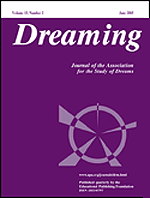 In the current issue of the IASD journal Dreaming (Vol. 22, No. 4, pp. 240-252) I have an article with results of a blind word search analysis of a teenage girl’s dream series. (Many thanks to the anonymous dreamer, “Bea,” and to Bill Domhoff for mediating our interactions.) The article is my latest effort at developing a method of using statistical patterns in word usage frequency to identify meaningful continuities between dream content and waking life concerns. I think the results show that we’re making good progress. Here is the abstract of the paper:
In the current issue of the IASD journal Dreaming (Vol. 22, No. 4, pp. 240-252) I have an article with results of a blind word search analysis of a teenage girl’s dream series. (Many thanks to the anonymous dreamer, “Bea,” and to Bill Domhoff for mediating our interactions.) The article is my latest effort at developing a method of using statistical patterns in word usage frequency to identify meaningful continuities between dream content and waking life concerns. I think the results show that we’re making good progress. Here is the abstract of the paper:
“Previous studies of dreaming in adolescence have found that 1) shifts in dream content parallel shifts in cognitive and social development and 2) adolescent girls seem more prone than boys to disturbing dreams and recurrent nightmares. This paper confirms and extends those findings by using a novel method, blind word searches, to provide results that are more precise, detailed, and objective than those offered by previous studies. The method is used to analyze a series of 223 dreams recorded in a private diary by an American girl, “Bea” (not her real name) from the ages of 14 to 21. Accurate predictions about continuities between Bea’s dream content and waking life concerns included important aspects of her emotional welfare, daily activities, personal relationships, and cultural life. The results of this analysis illuminate the multiple ways in which dream content accurately reflects the interests, concerns, and emotional difficulties of an adolescent girl.”
And here are the final two paragraphs:
“These findings underscore an important yet frequently misunderstood point about the continuity hypothesis: The strongest continuities between dreaming and waking relate to emotional concerns rather than external behaviors (Hall and Nordby 1972; Domhoff, Meyer-Gomes, and Schredl, 2005-2006). Many of Bea’s nightmares do not reflect actual waking experiences, but they do accurately reflect the dire possibilities and worst-case scenarios that trouble her in waking life. Bea’s nightmares mirror her worries about things that might happen, not necessarily any actual events that have happened.
“For clinicians, therapists, counselors, and teachers who work with adolescents, the Bea series adds new empirical depth to the idea that dreams are meaningful expressions of emotional truth, especially around issues of family history and personal relationships, and perhaps especially for adolescent girls. It remains to be seen if word search analyses have any further practical value, but the results presented here should certainly encourage anyone who works with teenagers to listen carefully to their dreams for potentially valuable insights into their developmental experiences.”
